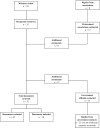Health system strategies supporting transition to adult care
- PMID: 25688098
- PMCID: PMC4453494
- DOI: 10.1136/archdischild-2014-307320
Health system strategies supporting transition to adult care
Abstract
Background: The transition from paediatric to adult care is associated with poor clinical outcomes, increased costs and low patient and family satisfaction. However, little is known about health system strategies to streamline and safeguard care for youth transitioning to adult services. Moreover, the needs of children and youth are often excluded from broader health system reform discussions, leaving this population especially vulnerable to system 'disintegration'.
Objectives: (1) To explore the international policy profile of paediatric-to-adult care transitions, and (2) to document policy objectives, initiatives and outcomes for jurisdictions publicly committed to addressing transition issues.
Methods: An international policy scoping review of all publicly available government documents detailing transition-related strategies was completed using a web-based search. Our analysis included a comparable cohort of nine wealthy Organisation for Economic Co-operation and Development (OECD) jurisdictions with Beveridge-style healthcare systems (deemed those most likely to benefit from system-level transition strategies).
Results: Few jurisdictions address transition of care issues in either health or broader social policy documents. While many jurisdictions refer to standardised practice guidelines, a few report the intention to use powerful policy levers (including physician remuneration and non-physician investments) to facilitate the uptake of best practice. Most jurisdictions do not address the policy infrastructure required to support successful transitions, and rigorous evaluations of transition strategies are rare.
Conclusions: Despite the well-documented risks and costs associated with a poor transition from paediatric to adult care, little policy attention has been paid to this issue. We recommend that healthcare providers engage health system planners in the design and evaluation of system-level, policy-sensitive transition strategies.
Keywords: Adolescent Health; General Paediatrics; Health services research; Paediatric Practice.
Published by the BMJ Publishing Group Limited. For permission to use (where not already granted under a licence) please go to http://group.bmj.com/group/rights-licensing/permissions.
Similar articles
-
Multidisciplinary Support for Healthcare Transitioning Across an Urban Healthcare Network.J Pediatr Nurs. 2015 Sep-Oct;30(5):677-83. doi: 10.1016/j.pedn.2015.05.011. J Pediatr Nurs. 2015. PMID: 26117806
-
Implementation of a Transdisciplinary Team for the Transition Support of Medically and Socially Complex Youth.J Pediatr Nurs. 2015 Sep-Oct;30(5):661-7. doi: 10.1016/j.pedn.2015.07.003. Epub 2015 Jul 29. J Pediatr Nurs. 2015. PMID: 26233635
-
Crossing the transition chasm: experiences and recommendations for improving transitional care of young adults, parents and providers.Child Care Health Dev. 2011 Nov;37(6):821-32. doi: 10.1111/j.1365-2214.2011.01261.x. Child Care Health Dev. 2011. PMID: 22007982
-
Programmes to support paediatric to adult healthcare transitions for youth with complex care needs and their families: A scoping review.Child Care Health Dev. 2022 Sep;48(5):659-692. doi: 10.1111/cch.12984. Epub 2022 Mar 8. Child Care Health Dev. 2022. PMID: 35170064 Free PMC article.
-
Advancing healthcare transitions in the medical home: tools for providers, families and adolescents with special healthcare needs.Curr Opin Pediatr. 2013 Aug;25(4):439-46. doi: 10.1097/MOP.0b013e3283623d2f. Curr Opin Pediatr. 2013. PMID: 23770924 Review.
Cited by
-
Essen transition model for neuromuscular diseases.Neurol Res Pract. 2022 Sep 5;4(1):41. doi: 10.1186/s42466-022-00206-8. Neurol Res Pract. 2022. PMID: 36058951 Free PMC article.
-
A cross-sectional survey of services for young adults with life-limiting conditions making the transition from children's to adult services in Ireland.Ir J Med Sci. 2020 Feb;189(1):33-42. doi: 10.1007/s11845-019-02054-z. Epub 2019 Jul 4. Ir J Med Sci. 2020. PMID: 31273561
-
Psychologists and the Transition From Pediatrics to Adult Health Care.J Adolesc Health. 2015 Nov;57(5):468-74. doi: 10.1016/j.jadohealth.2015.07.011. J Adolesc Health. 2015. PMID: 26499856 Free PMC article.
-
Achieving 90-90-90 in paediatric HIV: adolescence as the touchstone for transition success.J Int AIDS Soc. 2015 Dec 2;18(Suppl 6):20257. doi: 10.7448/IAS.18.7.20257. eCollection 2015. J Int AIDS Soc. 2015. PMID: 26639113 Free PMC article.
-
Emergency admissions and long-term conditions during transition from paediatric to adult care: a cross-sectional study using Hospital Episode Statistics data.BMJ Open. 2018 Jun 22;8(6):e021015. doi: 10.1136/bmjopen-2017-021015. BMJ Open. 2018. PMID: 29934386 Free PMC article.
References
-
- British Columbia Medical Association. Closing the gap: Youth transitioning to adult care in BC. https://www.doctorsofbc.ca/files/1984BCMA%20Youth%20Transitions.web_.pdf (accessed 26 Feb 2014).
Publication types
MeSH terms
LinkOut - more resources
Full Text Sources
Other Literature Sources
Medical

